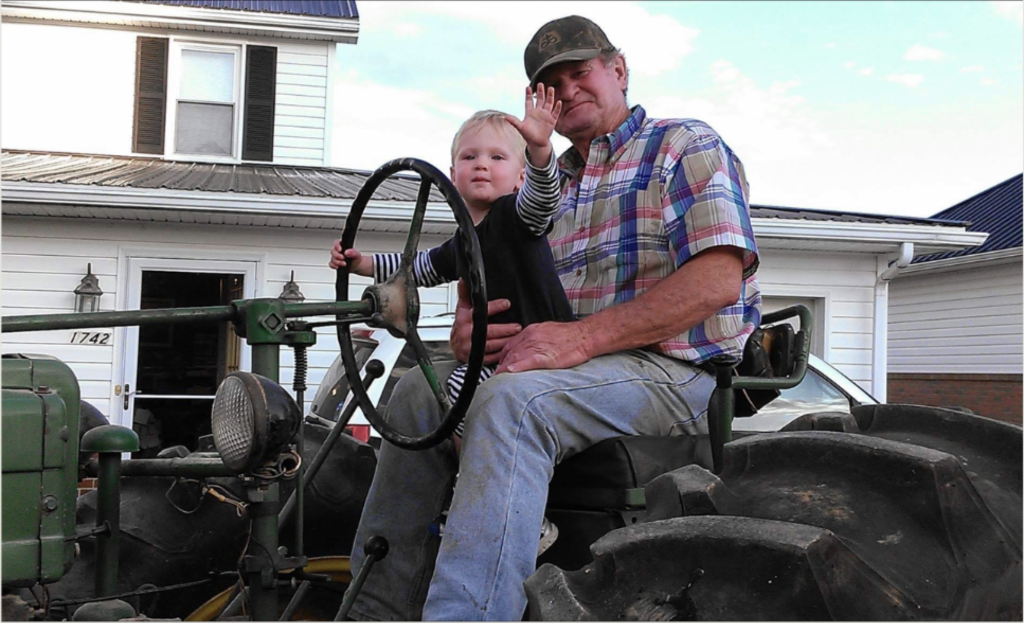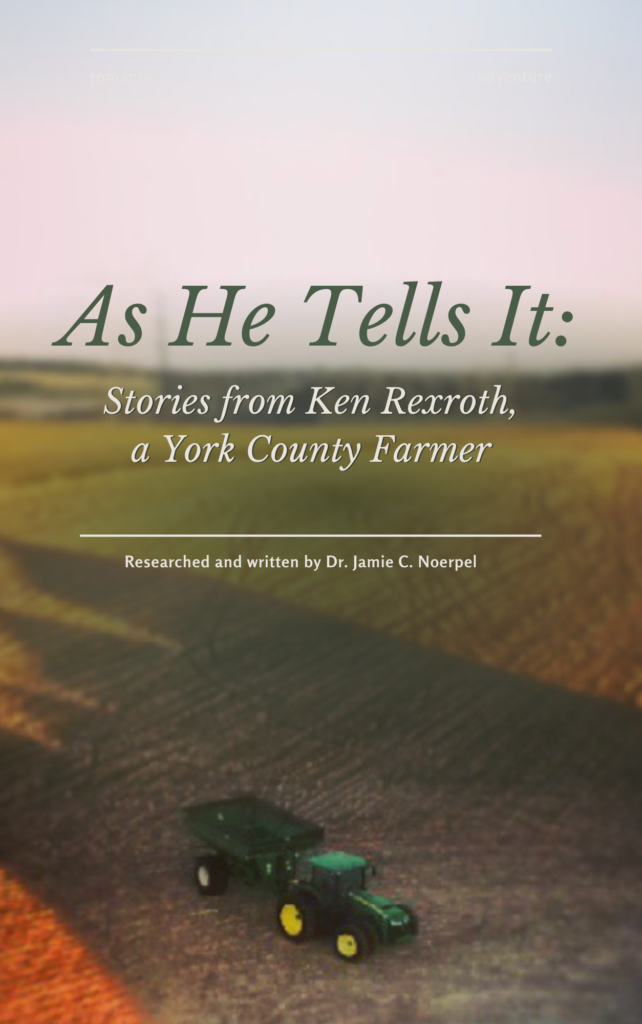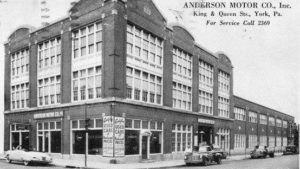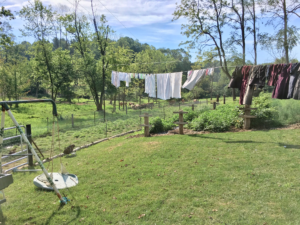‘She Tried to Keep Us Looking Decent’
Tough work for mother:
Raising 12 kids on a York County farm
1742 Winters Road, Windsor
The situation
Ken Rexroth grew up on a Windsor farm with 11 other siblings, raised by parents who overcame the Great Depression. Ken’s father and mother, Charles Rexroth and Sarah Smith, relied on their children to help with the chores. “I’m not going to sugar coat nothing.” Ken says. “At 15 you were out [of school],” motioning his thumb over his shoulder. For farming families, it wasn’t uncommon for education to end at the 8th grade. However, Ken insisted on finishing high school. It was tough – going to school all day and working at night – but he’s glad he soaked up as much education as he could.
Ken’s father passed away in 1963. As one of 12 siblings, Ken and his family had a lot to discuss, including dividing the family assets. “Then we had a real powwow,” he says. “It wasn’t easy baby.”
The future of the family farm hung in the balance. Bob Stewart, co-founder of Stewart and Tate, found out Ken’s dad passed away. “Stewart was always buying land,” Ken says. “He told the family that he’d pay them $40,000 for the 100 acres – dad had added to it.” At the time, Ken had recently graduated high school. “$40,000 for a 20-year-old kid was a lot of money,” Ken laments. But Stewart had set the price, so Ken went to the family with that sum as his own proposal.
They agreed. The farm would be his. And the farm has continued in his family’s name ever since.

Today, most Americans live in an urban setting, including York County. However, we began as an agricultural community. When did the shift from rural to urban occur? The change occurred in the decade after 1976. In that year, over half of the land in York County was still used for farming. However, by 1987 the majority of York County land was used for something other than farming. That means that more development occurred in the two decades leading up to 1996 than the previous two-hundred years.
Since then, more and more people are moving to the cities or suburbs. Considering the national shift from rural to urban occurred in 1920, York County held onto its agrarian roots longer than other parts of the country.
Regardless of our history, many people reading this don’t know what it’s like to grow up on a farm (let alone run one). In the winter of 2022, Jim Rexroth, Ken’s son, asked Jamie Noerpel to document the memories stored in Ken’s mind. Cancer had reared its ugly head, and even though Ken faced it head-on, he knew eventually death takes us all. She wrote “As He Tells It: Stories from Ken Rexroth, a York County Farmer” to preserve just a small segment of York County’s agricultural history.
It consists of 25 short chapters, each 2-5 pages long, and is available on Amazon for $11.95. All sales proceeds will be donated to the York County History Center.
Below is an excerpt from Chapter 10, describing what it was like raising 12 kids on a farm.
The witness
Chapter 10 – ‘She Tried to Keep Us Looking Decent’: Raising 12 Children
In the 1920s, the average rate of births per American woman ranged between three and five children. This was a steep drop from more than seven kids during the 1800s. However, the Rexroths blew those numbers out of the water.
Starting in 1928, Ken’s parents, Charles Clinton and Sarah Ellen Smith, had a baby every two years. Dorothea came first in 1928 followed by Charles, Robert, Ardella, Donald, Rosella, Vernon, Nevin, Ken, Claire, Blaine, and finally Sallie – four girls and eight boys, totaling 12 children. “But my dad wasn’t the winner,” Ken says. “The next-door place had 17 kids!”
Ken says Dorothea named him along with his other siblings, “I don’t think my mother gave a hoot about the names.” Where did Dorothea come up with Ken’s name? Ken’s cousin came to the house frequently to visit with Dorothea. About the time of Ken’s birth in 1943, she “started going with this guy named Ken Flaharty,” Ken says. “Then here I came along.”
Growing up with 11 siblings in a farmhouse meant Ken learned how to share space. Upstairs, called the long bedroom, slept all the boys. The girls slept in the other two rooms upstairs, and their parents occupied the room downstairs. “I do remember when my oldest sister got pregnant,” Ken says. “She had a baby, and her and her husband lived there.”
The small house swelled at the seams with teenagers, pre-teens, toddlers, and newborns. At its height, Ken remembers a total of 18 hungry mouths encircling the kitchen table. And Mom cooked for all of them. After 12 children, Sarah developed warm, curvy angles great for cuddling. “Everybody loves your mom you know,” Ken discloses. “She was a wonderful lady.”
Ken distinctly remembers his mother at the sewing machine. She’d spend hours peddling her treadle sewing machine. Powered by pushing the foot peddle back and forth, Sarah expertly adhering patches to her children’s worn clothing. “She was always sewing stuff.” Ken remembers. Today, we can find them in antique stores or as decorations. But at one time, these sewing machines represented a woman’s ingenuity, and America’s industrial might in home economics.
“Then she got a blood clot,” Ken says rather quietly. “It was pretty devastating. She was in the hospital for a month. Then she had to stay bed ridden for six weeks. She had to learn to walk again.” The backbone of the family had fallen ill. It was during this time Ken realized how many sacrifices she made for the family.
During her recovery time, Ken and Nevin were assigned the housework. In addition to the “stuff outside,” the brother duo had to cook, clean, and pick up after their siblings. Never again would he take his mother for granted. Not only did she love them all unconditionally, but she kept the house functioning so the rest of them could focus on the family business – the farm.
Farm life meant chores. Girls milked the family cows, assisting with house chores and the garden. When they turned 17, they were expected to gain employment in the cigar factories. However, Ken knew at an extremely young age that he wanted agriculture for his occupation. He’s proud to say, “I never punched a clock in my life.”
Imagine 14 people with no washing machine. This was the reality of the Rexroth family. “First thing we did in the morning before we went to school,” Ken says, “was carry the hot water for the wash.” Each Rexroth was expected to scrub their own cloths, then place their clean yet dripping wet linens in a basket “so all my dad had to do was hang it on the line.” With mom sewing the cloths, the children washing, then dad drying, laundry was a family ordeal.
Eventually, after enough of her children came home with missing buttons, Sarah thought it wise to teach them how to sew them back on themselves. “If you walked in the house without a button,” Ken says trailing off again. It was important for Sarah that her children looked respectable. “She tried to keep us looking decent all the time.”
However, decency came at a cost. New wardrobes cost money, so Charles and Sarah stressed the importance of taking care of their garments. Once a year – during the fall when school started up – each child received two new pairs of jeans, two shirts, a couple pairs of socks, and a single pair of shoes. “That pair of shoes had to last you until the next school year,” says Ken.
When Ken jolted through a growth spurt, his toes would smash into the fronts of his shoes. Fortunately, the plethora of older brothers mean hand-me-downs were never too far out of reach. “Your first [Sunday shoes] were never new.” That also meant many of his “good” shoes turned into “work” shoes. Nonetheless, considering everyone one his street lived on a farm, those dirty, livestock-smelling soles didn’t matter much. “When you went to the one-room school, who gives a hoot if you had work shoes on!”
At the start of fourth grade, something special happened to Ken. He got to pick out his own shirt for the first time ever. “All the boys wore bib overalls,” Ken says with a disapproving frown. “I begged and pleaded, ‘please,’ I said, ‘I want a pair of pants with a belt.’ I got it,” he says delightedly. “I just fell out of love of bib overalls, and I swore I wouldn’t wear them then ,and I still don’t wear them now.”
The Rexroths weren’t rich, but they weren’t poor either. These frugal customs were commonplace in York County during the 1940s. There’s pride in Ken’s voice when he says, “I don’t want to sound poor or anything, because we weren’t.” Even so, modern-day readers will appreciate the luxuries we have today.
One of his mom’s most prized possession was her china closet. She’d cherish the dishes and teacups, making sure to spot clean them, neatly placing them in organized sets. When his mom passed, the family sifted through her belongings, deciding what stayed and what went. Ken made sure to safeguard Sarah’s china closet, still preserving her treasure in his home to this day.

The questions
Through the written word, the Rexroths preserved a part of their family’s heritage. Ken’s memories are documented for generations to come. What are you doing to safeguard your own family history? If you’re not a writer, what other methods could you use to preserve the stories of your loved ones?
Related links and sources: Horn Farm Center Plans to Rise from Ashes; For the first time, Amish preserve land in the Farm and Natural Land Trust. Photos by the Rexroth Family.
— By JAMIE NOERPEL and JIM McCLURE



